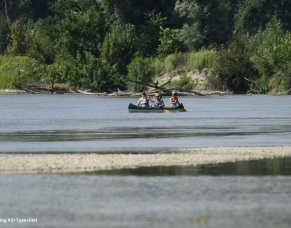Fertö-Hanság National Park
Cultural heritage along the Danube
This spectacular realm of water provided ample opportunity even for the people of the Neolithic Era. Artefacts from the Chalcolithic period and the Bronze Age certainly seem to support this theory, as do the finds left behind by the Iron Age man, the Illyrians, the Celts, the Huns and various Germanic tribes.
Pannonia, an ancient province of the Roman Empire, used to be bordered by Moson-Danube in the north, and mass migration only affected the periphery of Szigetköz. Initially populated by Eurasian Avars and Slavic peoples, the arrival of Hungarians (Chieftains Huba, Lehel, and Megyer) meant that Szigetköz was to be permanently settled by humans. Listed here are some of our oldest settlements with recorded history: Vének (1093), Dunakiliti, Halászi and Lipót (13th century).
While this enclosed water-world was spared from stormy and violent moments of history, the struggle between humans and their life-giving source, the Danube, was continuous. The frequent floods brought about the collapse of the river-banks, causing enormous damage and changing the layout of the Danube branches year after year. Adapting to the changing circumstances, the inhabitants of these settlements moved from island to island to find more filled-up areas. Various skills and crafts linked to this land and water flourished before regulation operations on the river commenced. Mysterious wanderers of the water labyrinth were the gold-seekers: this traditional craft passed from father to son. Similarly to fishermen’s, the gold-seekers’ were a close-knit community. They knew all there was to know about the river-banks and, when on the move, they built their own huts using reed.
A group called the ‘meadow people’ wandered the bogs, wetlands and floodplain forests collecting nature’s treasures. They caught leeches, crayfish, turtles; collected eggs, hawthorn berries, mushrooms and several herbs.
Szigetköz is an invaluable asset in terms of natural resources since it is the second largest source of drinking water in Hungary. The preservation of this land is vital to sustain its diverse habitats and quality of water.
In an attempt to preserve the characteristic flora and fauna and insular world of Szigetköz, the Szigetköz Landscape Protection Area was established in 1987. This covers an area of 10,127 hectares – approximately 27% of Szigetköz – with 1325 hectares being strictly protected, and 446 hectares Ex lege swampland.

